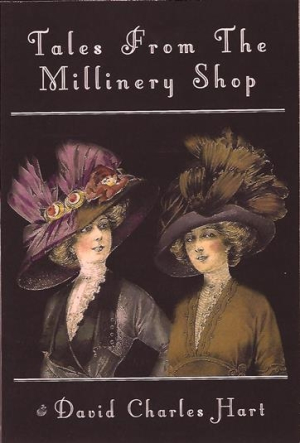Tales from the Millinery Shop
The satisfying stories of Tales from the Millinery Shop include forbidden romance, mystery, and women’s courage.
Engaging, entertaining, and at times disturbing, the stories in David Charles Hart’s Tales from the Millinery Shop reflect the glory and the depravity of America’s Gilded Age.
In Hart’s stories live an eclectic group of women millinery workers who design and create lush, oversized hats that are coveted by wealthy ladies. Their stories are set in upstate New York and reveal the women’s own hopes and dreams as they toil at a craft that caters to the whims of the rich.
The women’s captivating stories reveal the pride that they take in their work, the strong bonds of solidarity between them, and the fear that assails them because society considers them less than worthy. Written in a warm, conversational style, the entries are moving and sensitive as they deal with the women’s diverse backgrounds. A Jewish woman, disturbed that her family members have to work on the Sabbath, asks a colleague how she and other “colored people” handle “the discrimination and downright cruelty” they suffer. Their discussion reflects genuine interest and compassion and helps each of them learn about the other’s life and faith.
The book contrasts the respectful, affirming attitudes held by the shop’s workers with those of society at large. Among the millinery workers, friendship is valued, leadership is shown to be both strong and caring, and people are given the freedom to love whom they will. The stories are enticing looks at what society might be like were such attitudes to prevail.
While historical facts anchor the book in its time and place, the stories remain relevant, touching on issues of environmentalism, racism, and the effects of an economic system that rewards the few at the top while leaving the masses to scrape for a living. One story finds a young mother forced to sell her body and raise her daughter in a brothel in order to survive. Intriguing elements of mystery also arise: children have frightening nightmares; people disappear; and a strange woman who possesses the touch of death captivates, then kills.
The narrative stresses rising above differences to embrace unity. Religious symbolism and references are shown to bring people of different faiths together. While the stories are gripping, the heavy accents used to distinguish people from one another make the narrative drag, even as they make the characters more lifelike. The cockney accent of an unusual talking cat is especially cumbersome.
Errors in word usage and punctuation are frequent, and there are occasional mistakes in capitalization and hyphenation. The black-and-white images at the beginning of each chapter stand out with the exception of a music box photograph, which is blurred.
The satisfying stories of Tales from the Millinery Shop include forbidden romance, mystery, and the courage of a proud, diverse group of women who form enduring bonds of friendship.
Reviewed by
Kristine Morris
Disclosure: This article is not an endorsement, but a review. The publisher of this book provided free copies of the book and paid a small fee to have their book reviewed by a professional reviewer. Foreword Reviews and Clarion Reviews make no guarantee that the publisher will receive a positive review. Foreword Magazine, Inc. is disclosing this in accordance with the Federal Trade Commission’s 16 CFR, Part 255.

